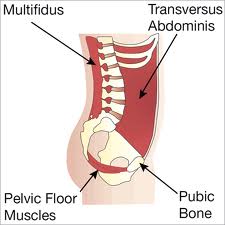Many overuse injuries from running can be prevented and even solved by having good core strength. Over the last few years, however, the “core” has become a buzzword among athletes, trainers, and people with back pain. Unfortunately, there is a lot of misleading information about which muscles make up the core.
The Truth About The Core
The outer core muscles consist of the rectus abdominus, internal and external obliques, latissumus dorsi, erector spinae, hip flexors, hip extensors, hip adductors and abductors. These are the larger, superficial muscles that play a smaller role in stabilization and a larger role in moving the limbs in relation to the trunk. These muscles are easier to recruit, and with inactivity tend to become tighter and stiffer.
The deeper core muscles consist of the transverse abdominus, multifidus, and the pelvic floor muscles. These are the smaller, deeper muscles that are closer to the spine. They act like a lumbar corset when they work properly. Unfortunately, these muscles are the first to become atrophied when an injury occurs to the back or when you are sedentary.
 Using The Core Muscles To Overcome Overuse Injuries From Running
Using The Core Muscles To Overcome Overuse Injuries From Running
Research studies have shown that people with low back pain tend to have ineffective recruitment of deep core muscles, particularly of the transverse abdominus. If the core muscles are not working properly, it can lead to back pain or other overuse injuries from running. Core training has been shown to decrease low back pain. In general training begins with the deeper core muscles, which are usually weaker, and progressing to the more global muscles of the outer core. Starting with slow, controlled movements with low resistance will encourage the deeper core muscles to work. If you are moving quickly and using higher resistance you are most likely recruiting the superficial muscles and missing out on activating the deeper core muscles.
The key to quick results in overcoming overuse injuries from running or any other activity is specificity. Physical therapists are trained to identify where the pain is stemming from and creating a program that matches the specific needs of the individual. If you are experiencing pain from overuse injuries from running or other activities, contact us so you get back to doing what you love quickly and safely.
